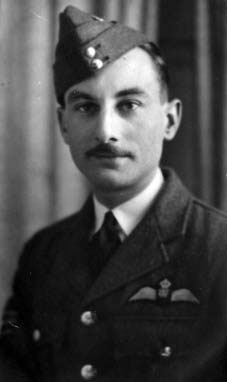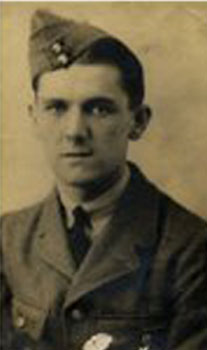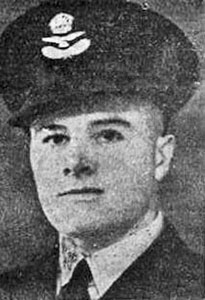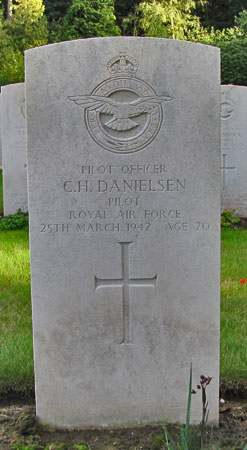Manchester L7428 near Scaftworth, Bawtry.
In December 2010 I was contacted by the son of the pilot killed in this accident, he has been researching his father's flying for many years and suppied some of the information given on this webpage. I thank him for allowing this. This incident did not actually crash in Yorkshire, it's was one just over the border into Lincolnshire but I will keep the webpage as it contains a reasonable degree of information that might be of interest to someone.
On the afternoon of 18th November 1941, Manchester L7428 of 25 O.T.U. based at RAF Finningley, was operating from Bircotes airfield which was a grass aerodrome next door to RAF Bawtry, the headquarters of No.1
Group Bomber Command which occupied the eighteenth century Bawtry Hall. The reason for flying from
this satellite was probably because the crew, which consisted of a number of pilots,
were to practice taking turns at taking-off and landing away from the busy and crowded Finningley
airfield. It is possible that the aircraft had just taken off with F/Sgt Adams at the controls when
the port engine caught fire in flight. This could have been due to the excessive strain that multiple
take-offs placed on the unreliable Vulture engines. The subsequent investigation into the crash
believed that the aircraft was at an altitude from which the pilot was unable to make a safe
landing on only one engine, particularly as the propeller of the stricken engine had not been
feathered. The accident Card for L7428 suggests two possible causes for this; either the pilot
had failed to feather the propeller, or the engine fire effected the hydraulic pump or oil pipe
that controlled the propeller feathering equipment, putting it out of action.
According to eyewitnesses, at 16.25hrs the aeroplane was flying very low over Bawtry village
when it descended even lower over some farm buildings. It then turned sharply to the left before
violently striking the ground through a hedge at Scaftworth, two miles to the south-east of
Bircotes at 16.32hrs. The aircraft was burnt out. Tragically, this accident resulted in the death
of three of the five crew on board.
Manchester L7428 was built to contract 648770/37/C4(c) by A.V. Roe & Co. Ltd. at Chadderton and was awaiting collection in April 1941. The aircraft was allotted to 25 O.T.U. on 11th June 1941 and was one of a batch of nine Manchester's allotted for use by 25 O.T.U. at that time (L7325, L7420, L7421, L7428, L7429, L7430, L7431, L7434, & L7456). All survived their service with 25 O.T.U. apart from L7428. Manchester L7428 was taken on charge by 25 O.T.U. at Finningley on 2nd July 1941. It crashed near Bawtry on 18th November 1941 and received the damage assessment of Cat.E2/FA which wrote off the aircraft. The wrecked aircraft was not initially scrapped. It was taken to A.V.Roe Ltd at Brace Bridge on 4th December 1941 and was then struck off charge on 2nd January 1942.
Pilot (captain of aircraft at the time) - F/Sgt Linford Herbert Adams DFM RAFVR (742983), aged 26, of Southend on Sea. Buried Southend on Sea, Essex.
Pilot - F/Sgt Ronald William Hazard Baxter DFM RAFVR (742962), aged 22. Of Letchworth. Buried Letchworth, Hertfordshire.
Pilot - P/O Christopher Hugh Danielsen RAFVR (62702), of Edgbaston, Birmingham. Injured.
Observer(/Wireless Operator) - F/O Desmond Barton Elleray RAAF (404091), of Toowoomba, Queensland, Australia. Buried Finningley Churchyard Extension, Yorkshire.
Wireless Operator - Sgt Robert Rowell RAFVR (1061453), of Kibbleworth, Durham. Injured.
Linford Adams' medal set and service details were auctioned in 2007 by Spinks of London and the
auction catalogue gave extra details about his life. Further correspondance with his son has yielded
much more information. Linford Adams was born in Hornsey, London
in 1915 but was educated at Southend High School.
He joined the RAFVR in February 1939 and trained with 16 OTU from 4th May to 9th August 1940. He was posted to 106 Squadron
based at Finningley for a brief period until 25th August 1940 when he was posted to Lindholme to 50 Squadron to fly as
navigator/bomb aimer on Hampdens. He flew twenty nine operational flights with 50 Squadron, including mine-laying and
bombing the occupied Channel Ports and mainland Europe. He was a married man with three children.
On 20th September 1940 an operational flight to Holland had to be aborted because the port engine
appeared to be on fire. The captain ordered the crew to abandon the aircraft over Lincolnshire, but
only Adams complied and landed safely at Hemswell, the others preferring to take their chances with
a forced landing. The pilot, Sgt Crum, was able to land safely back at base. Sgt Adams thus
qualified for membership of the Caterpiller Club.
On 17th November 1940 when returning from Ops to Spiekebroog in Hampden X3022, the flare-path
at Lindholme was unlit which caused Sgt Crum, the pilot, difficulty in finding the runway. The aircraft
swung on hitting the waterlogged grass and crashed, resulting in minor damage which was repaired on site.
This Hampden was in service for another two years before it was handed over to the Russian Navy.
On 25th November 1940 Hampden X3125 was returning from a ten hour trip to Kiel when it ran out
of fuel. It crash-landed at Mapplethorpe, Lincolnshire, and was written off. The crew suffered
various injuries, Adams being off Ops for several weeks. I thank Mr C. Paul Adams, son of Linford Adams for contacting me in December 2010 and for the additional information he was kind enough to
provide this account.
On completion of his Tour he was posted to 25 OTU to instruct on 28th February 1941, he was awarded the DFM for service
with 50 Squadron (Gazetted on 25th April 1941) but no citation has yet been found. He received his medal from King George
VI at Buckingham Palace two weeks before he was killed in the incident detailed above.
Sgt Rowell injured his arm in the accident to Manchester L7428 in November 1941, he recovered from his injuries and was later posted to 144 Squadron. On 7th February 1942 posted missing on a mine-laying flight in Hampden AD824. He was twenty one years old and is commemerated on the Runnymede Memorial. I thank his niece Miss G. Rowell for contacting me in November 2011 and for the additional information and photograph she was kind enough to provide this account.
Desmond Elleray was born on 11th May 1918 in Nambour, Queensland, he worked as a storekeeper when he enlisted on 24th May 1940 in Brisbane.
Although not unique, he was a Quaker. He was commissioned to P/O on 14th March 1941 and rose to F/O on 14th September 1941.
On arrival in the UK he trained at 25 OTU at Finningley from 16th August 1941. For an unknown reason he was admitted to Raucby Hospital in
Lincolnshire in 1941, and was discharged on 31st October 1941.
On 25th March 1942, P/O Danielsen was Captain of Manchester L7465 which was part of a group of bombers including Hampdens, Whitleys and
Wellingtons which were to bomb Essen in Germany. Before they reached their target, they encountered enemy anti-aircraft gunfire over Belgium,
a direct hit sending the Manchester crashing to the ground in flames at Lichtaart, instantly killing all on board. The seven allied crewmen
were initially buried at Lichtaart with
full military Honours by the German Army, but they have subsequently been re-interred in the Heverlee War Cemetery, Belgium.
In March 2009, a group of dedicated enthusiasts from the Sussex based Wings Museum travelled to the crash site in Belgium
to erect a memorial which was unveiled in memory of the crew of Manchester L7465 who lost their lives on the night of 25/26th March 1942.
See their web site for details. "www.wingsmuseum.co.uk/manchester_l7465_memorial_belgium.htm". I thank Mr Ade Harris for the photograph of his gravestone.




Ron Baxter's DFM was awarded for service with 83 Squadron (Gazetted on 17th January 1941). No citation has been found for this award. Nothing more is known about him.
Christopher Hugh Danielsen was from Edgbaston, Birmingham and like the other two British pilots had gained his entry to the RAF through
the Volunteer Reserve. He received his commission on 27th March 1941 to P/O on probation. After he recovered from the injuries
sustained in the above accident, he finished his course at 25 OTU and was transferred
to 83 Squadron who were just starting to fly Manchesters on operations from RAF Scampton.
